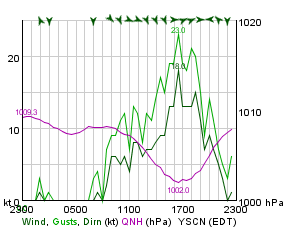Flying Training
Lesson 41: Crosswind Circuits 2
Sunday 28 January 2007, 2.30pm in Citabria RRW. Instructor: Rob Marshall.
Weather: clear, sunny, warm and bumpy, with an inconsistent and gusty wind.
Holiday over; now it's back to the serious business of passing the
 GFPT.
It's been nearly 3 months since my last flight in a tailwheel aircraft,
so the first step was to find out how much I'd remembered. Rob suggested we combine this with crosswind training, as it's
important that I keep progressing through the syllabus. We were looking initially at circuits on 06, with a move to 10/28
later to increase the crosswind component. As it turned out, the wind had other ideas.
GFPT.
It's been nearly 3 months since my last flight in a tailwheel aircraft,
so the first step was to find out how much I'd remembered. Rob suggested we combine this with crosswind training, as it's
important that I keep progressing through the syllabus. We were looking initially at circuits on 06, with a move to 10/28
later to increase the crosswind component. As it turned out, the wind had other ideas.
 I'd arrived early so there was plenty of time for a thorough preflight. RRW
is temporarily without wheel spats, so has a rather rugged appearance.
Other than that, all was well. When I opened the door, the smell of vinyl in the hot sun brought
back memories of other lessons, mainly with good associations, some not so
good. I sat
I'd arrived early so there was plenty of time for a thorough preflight. RRW
is temporarily without wheel spats, so has a rather rugged appearance.
Other than that, all was well. When I opened the door, the smell of vinyl in the hot sun brought
back memories of other lessons, mainly with good associations, some not so
good. I sat
 in the seat and checked I had full rudder travel. (In the light
of this lesson it might have been good to have the seat forward a notch as
I spent some time on takeoff with the stick in the far left corner, arm
outstretched.)
in the seat and checked I had full rudder travel. (In the light
of this lesson it might have been good to have the seat forward a notch as
I spent some time on takeoff with the stick in the far left corner, arm
outstretched.)
Rob lent me a Bose headset, and showed me the difference between having the Active Noise Reduction turned on and off. It's certainly very comfortable. I followed the check list to start up (but I somehow forgot the strobes, which are the 'S' in Kerry's ROARS checks). While checking the oil temperature and pressure, Rob pointed out that the temperature is not important, but the pressure must be in the green within 30 seconds. (According to Jim Davis, Lycoming actually recommends that the pilot should minimise ground running, and not wait for the temperature to enter the green. Continental have a different recommendation.)
I taxiied for 06, carried out the run-up checks and stopped short of the
hold point, at 45°, to call for clearance, which we received. As we
 lined up, Rob told me to check the windsock and plan my control inputs
accordingly. The wind was from the left, so he said put in some left aileron,
and use right rudder once the stick was forward to compensate for the
weathercocking. I did as he said, but not nearly enough, and we headed
towards the right side of the runway. I could blame the conditions but it
was obvious that I was seriously rusty after three months absence. Rob
explained that pretty much full aileron was required, and more rudder. The
diagram on the right (from the Flight Sim Handbook) explains it pretty
clearly. Note that after takeoff you straighten the wings and use the rudder
to crab into wind to track the extended runway centreline.
lined up, Rob told me to check the windsock and plan my control inputs
accordingly. The wind was from the left, so he said put in some left aileron,
and use right rudder once the stick was forward to compensate for the
weathercocking. I did as he said, but not nearly enough, and we headed
towards the right side of the runway. I could blame the conditions but it
was obvious that I was seriously rusty after three months absence. Rob
explained that pretty much full aileron was required, and more rudder. The
diagram on the right (from the Flight Sim Handbook) explains it pretty
clearly. Note that after takeoff you straighten the wings and use the rudder
to crab into wind to track the extended runway centreline.
I climbed out at 70 knots, turned onto crosswind and checked the runway. At this point Rob suggested I call for a stop and go, to give me a chance to practice crosswind takeoffs as well as the landings. We did this for every circuit.
(Incomplete)
Photos
 Maule |
 Maule |
 Maule |
|
 Lear Jet |
 Lear Jet |
 Lear Jet |
|
 Yak-52 |
 Yak-52 |
 Yak-52 |
 Yak-52 |
 RRW |
 Hanger |
